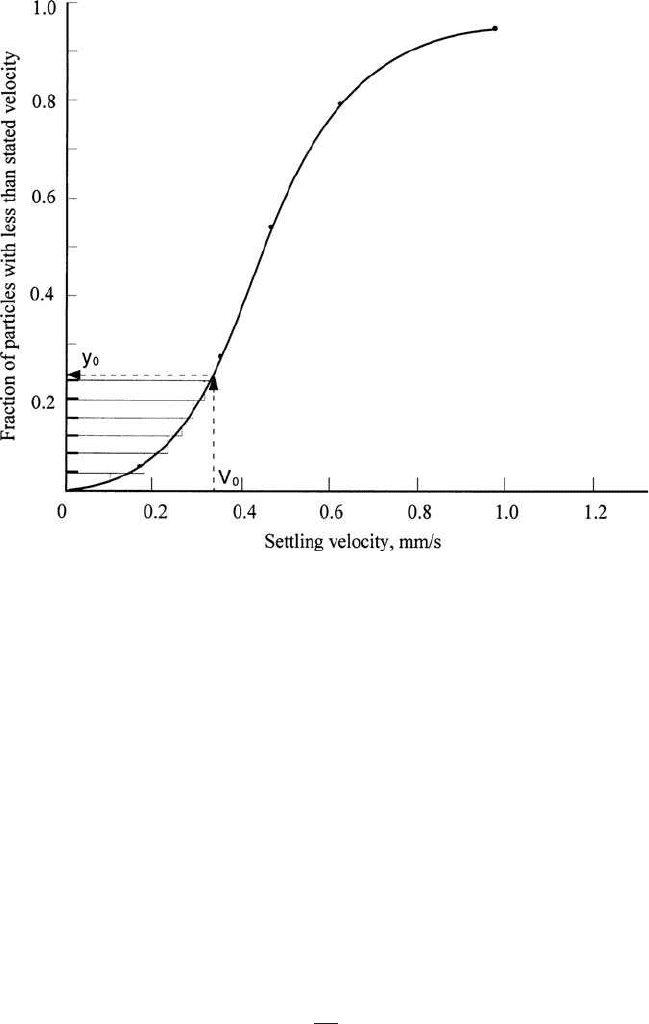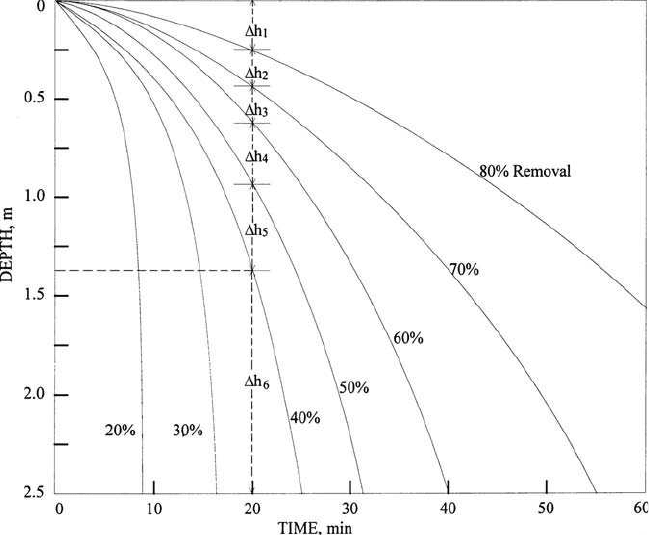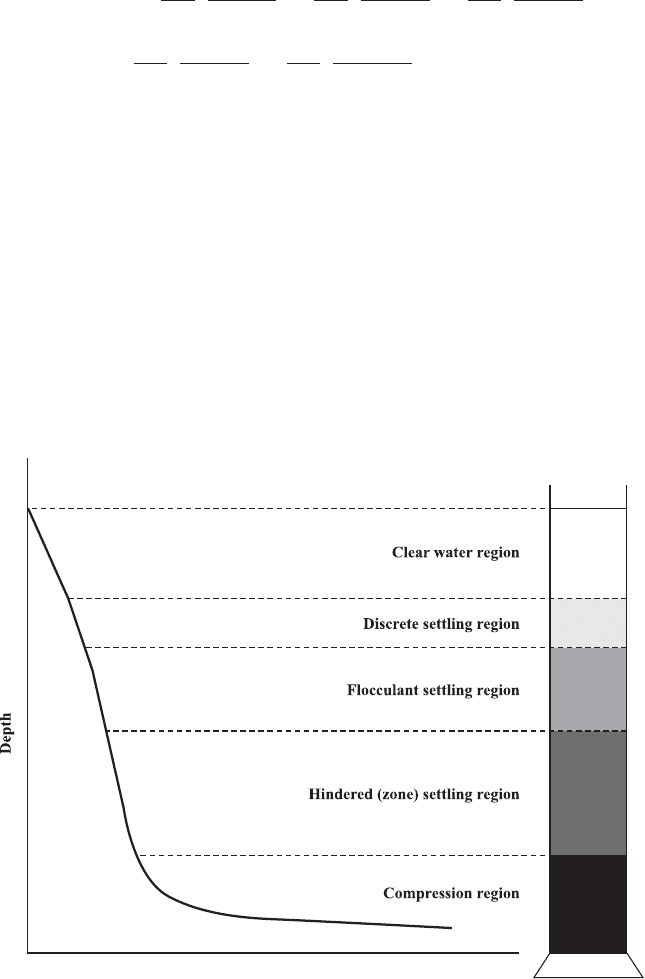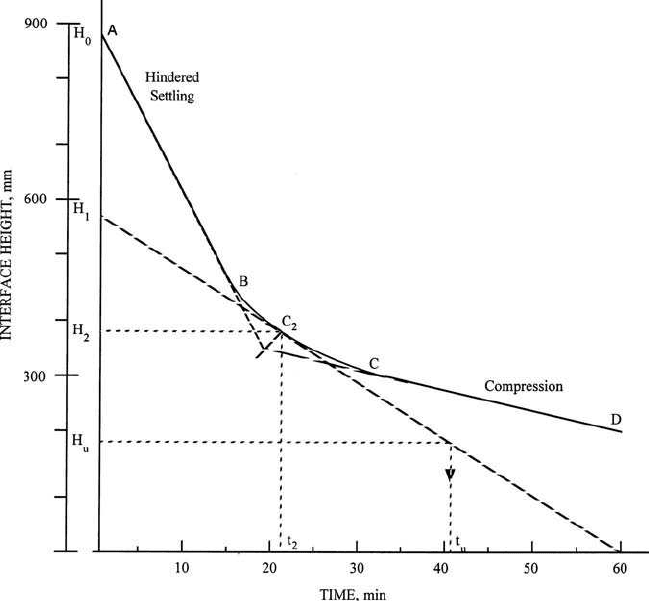Lin S.D. Water and Wastewater Calculations Manual
Подождите немного. Документ загружается.


Note: The grit chamber is designed to have a surface overflow rate (settling
velocity) of 2.1 cm/s and a horizontal velocity less than 22.8 cm/s but greater
than 7.9 cm/s. Under these conditions, the grit will be removed and organic
matter will not. If the horizontal velocity is close to the scour velocity, the grit
will be reasonably clean.
18.3 Sedimentation tank (basin)
configuration
Sedimentation tanks can be rectangular, square or circular. Imhoff
tanks perform the dual function of settling and aerobic treatment with
two-story chambers; however, the Imhoff tank is old technology and is
no longer allowed in the developed countries.
For a continuous flow sedimentation tank, the shape can be either rec-
tangular or circular. Camp (1953) divided the ideal sedimentation tank
into four zones which affect settling, namely the inlet zone, theoretical
effective settling zone, sludge zone (beneath the settling zone), and
outlet zone (Fig. 6.6). The inlet and outlet condition and tank geometry
influence short circuiting, which can be minimized in narrow rectangular
horizontal flow basins. Short circuiting is a common problem in circu-
lar radial flow clarifiers.
Figure 6.6 illustrates an ideal rectangular continuous horizontal flow
settling tank. The inlet zone uniformly distributes wastewater flows
and solids over the cross-sectional area of the tank in such a manner that
flow through the settling zone follows horizontal paths to prevent short
circuiting. In the settling zone, a uniform concentration of particles set-
tles at terminal settling velocity to the sludge zone at the bottom of the
tank. In the real world, there is no theoretical effective settling zone.
Particle settling vectors are difficult to predict. However, it is usually
assumed that the flow of wastewater through the settling zone is steady
Wastewater Engineering 595
Figure 6.6 Sketch of the discrete particle settling in an ideal settling tank.

and that the concentration of each sized particle is uniform throughout
the cross section normal to the flow direction. The sludge zone is a
region for storing the settled sediments below the settling zone. This
zone may be neglected for practical purposes, if mechanical equipment
continually removes the sediment. In the outlet zone, the supernatant
(clarified effluent) is collected through an outlet weir and discharged to
further treatment units or to the outfall.
In the design of clarifiers, a particle terminal velocity V
0
is used as a
design overflow settling velocity, which is the settling velocity of the
particle which will settle through the total effective depth H of the tank
in the theoretical detention time. All particles that have a terminal
velocity (V
s
) equal to or greater than V
0
will be removed. The surface
overflow rate of wastewater is (Stoke’s law)
(6.40)
(6.41)
where Q ⫽ flow, m
3
/d or gal/d
A ⫽ surface area of the settling zone, m
2
or ft
2
V
0
⫽ overflow rate or surface loading rate, m
3
/(m
2
⭈ d)
or gal/(ft
2
⭈ d)
W, L ⫽ width and length of the tank, m or ft
This is called type 1 settling. Flow capacity is independent of the depth
of a clarifier. Basin depth H is a product of the design overflow velocity
and detention time t
H ⫽ V
0
t (6.42)
The flow through velocity V
f
is
V
f
⫽ Q/HW (6.43)
where H is the depth of the settling zone. The retention time t is
t ⫽ Volume/Q (6.44)
The removal ratio r (or fraction of removal) of particles having a
settling velocity equal to V
s
will be h/H. Since depth equals the product
of the settling velocity and retention time t (Fig. 6.6)
(6.45)
r 5
h
H
5
V
s
t
V
0
t
5
V
s
V
0
5
gsr
s
2 rdd
2
18m
V
0
5 Q/A 5 Q/WL
596 Chapter 6

where r is the fraction of the particles with settling velocity V
s
that are
removed. This means that in a horizontal flow particles with settling
velocity V
s
less than V
0
will also be removed if they enter the settling
zone at a depth less than H.
The settling velocity distribution for a suspension sample can be
determined from a column settling test. The data obtained from the
test can be used to construct a cumulative settling velocity frequency dis-
tribution curve, as shown in Fig. 6.7.
For a given clarification flow rate Q, only those particles having set-
tling velocity ⱖ V
0
(⫽ Q/A) will be completely removed. Let y
0
represent
the portion of particles with a settling velocity ⬍V
0
; then the percent-
age removed will be 1 ⫺ y
0
. Also, for each size particle with V
s
⬍ V
0
its
proportion of removal, expressed as Eq. (6.45), is equal to r ⫽ V
s
/V
0
.
When considering various particle sizes in this group, the percentage
of removal is
3
y
0
0
V
s
V
0
dy
Wastewater Engineering 597
Figure 6.7 Cumulative particles removal versus settling velocity curve.

The overall fraction of particles removed, F, would be
(6.46)
Approximation:
(6.47)
where y
0
⫽ fraction of particles by weight with V
s
ⱖ V
0
i ⫽ ith particle
Example: (type 1): A clarifier is designed to have a surface overflow rate
of 28.53 m
3
/(m
2
⭈ d) (700 gal/(ft
2
⭈ d)). Estimate the overall removal with the
settling analysis data and particle size distribution in columns 1 and 2 of
Table 6.9. The wastewater temperature is 15⬚C and the specific gravity of
the particles is 1.20.
solution:
Step 1. Determine settling velocities of particles by Stoke’s law, Eq. (6.41)
From Table 4.1a, at 15⬚C
where d is in m
Step 2. Calculate V for each particle size (col. 3 of Table 6.9)
5 96,942 d
2
m/s
5
9.81 m/s
2
s1200 2 999d kg/m
3
3 d
2
18 3 0.00113 kg/ss
#
md
V 5
gsr
s
2 rdd
2
18m
r 5 0.9990
m 5 0.00113 N
#
s/m
2
5 0.00113 kg/ss
#
md
F 5 1 2 y
0
1
1
V
0
⌺
V ⌬y
1
V
i
1 V
i11
2V
0
sy
1
2 y
i11
d
F 5 1 2 y
0
1
V
0
1 V
1
2V
0
sy
0
2 y
1
d 1
V
1
1 V
2
2V
0
sy
1
2 y
2
d 1
c
F 5 s1 2 y
0
d 1
1
V
0
3
y
0
0
V
s
dy
598 Chapter 6

For d ⫽ 0.1 mm ⫽ 0.0001 m
V ⫽ 96,942 (0.0001)
2
⫽ 0.000969 (m/s)
⫽ 0.968 mm/s
Similarly, calculate the settling velocities for other particle sizes
Step 3. Construct the settling velocities versus cumulative distribution
curve shown in Fig. 6.7
Step 4. Calculate designed settling velocity V
0
V
0
⫽ 28.53 m/d
⫽ 28,530 mm/d ⫻ 1 d/86,400 s
⫽ 0.33 mm/s
Note: All particles with settling velocities greater than 0.33 mm/s (700 gal/
(d ⭈ ft
2
)) will be removed.
Step 5. Find the fraction (1 ⫺ y
0
)
From Fig. 6.7 we read
then
Step 6. Graphical determination of ⌺V⌬y
Referring to Fig. 6.7
⌺
V⌬y 5 0.0569
⌬y 0.04 0.04 0.04 0.04 0.04 0.04 0.01
V 0.09 0.17 0.23 0.26 0.28 0.31 0.33
V⌬y 0.0036 0.0068 0.0092 0.0104 0.0112 0.0124 0.0033
1 2 y
0
5 1 2 0.25 5 0.75
y
0
5 0.25 at V
0
5 0.33 mm/s
Wastewater Engineering 599
TABLE 6.9 Results of Settling Analysis Test and
Estimation of Overall Solids Removal
Particle size Weight fraction Settling velocity
mm < size, % V, mm/s
0.10 12 0.968
0.08 18 0.620
0.07 35 0.475
0.06 72 0.349
0.05 86 0.242
0.04 94 0.155
0.02 99 0.039
0.01 100 0.010

Step 7. Determine overall removal R
Using Eq. (6.47)
18.4 Flocculant settling (type 2)
In practice, the actual settling performance cannot be adequately pre-
dicted because of unrealistic assumptions on ideal discrete particle
settling. Under quiescent conditions, suspended particles in water or
wastewater exhibit a natural tendency to agglomerate. Also, sus-
pended solids in wastewater are not discrete particles and vary more
than light and small particles, as they contact and agglomerate and
grow in size. As coalescence of flocculation occurs, including chemi-
cal coagulation and biological flocs, the mass of the particles increases
and they settle faster. This phenomenon is called flocculant or type 2
sedimentation.
The flocculation process increases removal efficiency but it cannot be
adequately expressed by equations. Settling-column analysis is usually
used to determine the settling characteristics of flocculated particles. A
column can be of any diameter and equal in length to the proposed clar-
ifier. Satisfactory results can be achieved with 15 cm (6 in) diameter plas-
tic tube 3 m (10 ft) in height (Metcalf and Eddy, Inc. 1991). Sampling
ports are uniformly spaced (45 to 60 cm or 1.5 to 2 ft) along the length
of the column. The test suspension is placed in the settle-column and
allowed to settle in a quiescent manner. The initial suspended solids con-
centration is measured. Samples are withdrawn from the sampling
ports at various selected time intervals from different depths. Analyses
of SS are performed for each sample, and the data used to calculate the
percentage of removal is plotted as a number against time and depth.
Between the plotted points, curves of equal percent removal are drawn.
The results of settling-column analyses are presented in Fig. 6.8. Use
of the curves in Fig. 6.8 is illustrated in the following example.
Example: Using the settling curves of Fig. 6.8, determine the overall removal
of solids in a sedimentation basin (type 2 flocculant settling) with a depth
equal to the test cylinder and at a detention time of 25 min. The total depth
is 2.5 m.
5 92%
5 0.92
5 0.75 1 0.0569/0.33
F 5 s1 2 y
0
d 1
1
V
0
⌺
V⌬y
600 Chapter 6

solution:
Step 1. From Fig. 6.8, 40% of the particles will have a settling velocity of
0.1 m/min (2.5 m/25 min)
At t ⫽ 25 min, the volume of the test cylinder within ⌬h
6
has 40% removal.
Step 2: Determine percent removal of each volume of the tank
In the volume of the tank corresponding to ⌬h
5
between 50% and 40% removal
will occur. Similarly, in the tank volume corresponding to ⌬h
4
between 60% and
50% will be removed. In like fashion, this is applied to other tank volumes.
Step 3. Calculate the overall removal
Since 1/h ⫽ 1/2.5 ⫽ 0.4
⌬h
4
5 0.32 m
⌬h
3
5 0.20 m
⌬h
2
5 0.14 m
⌬h
1
5 0.23 m
Wastewater Engineering 601
Figure 6.8 Settling trajectory characteristics for flocculent particles.

18.5 Hindered sedimentation (type 3)
In systems with high concentrations of suspended solids, the velocity
fields of closely spaced particles are obstructed, causing an upward dis-
placement of the fluid and hindered or zone settling (type 3) and com-
pression settling (type 4). In addition, discrete (free) settling (type 1) and
flocculant settling (type 2) occur. This settling phenomenon of concen-
trated suspensions (such as activated sludge) is illustrated in a gradu-
ated cylinder, as shown in Fig. 6.9.
5 73.7% removal
1 0.14 3 75 1 0.23 3 90d
5 40 1 0.4s0.5 3 45 1 0.32 3 55 1 0.20 3 65
1
⌬h
2
h
a
70 1 80
2
b 1
⌬h
1
h
a
80 1 100
2
b
F 5 40 1
⌬h
5
h
a
40 1 50
2
b 1
⌬h
4
h
a
50 1 60
2
b 1
⌬h
3
h
a
60 1 70
2
b
⌬h
5
5 0.50 m
602 Chapter 6
Figure 6.9 Schematic drawing of settling regions for concentrated suspensions.

Hindered (zone) settling occurs in sludge thickeners and at the bottom
of a secondary clarifier in biological treatment processes. The velocity
of hindered settling is estimated by (Steel and McGhee, 1979)
v
h
/v ⫽ (1 ⫺ C
v
)
4.65
(6.48)
where v
h
⫽ hindered settling velocity, m/s or ft/s
v ⫽ free settling velocity, calculated by Eq. (6.33) or (6.38)
C
v
⫽ volume of particles divided by the volume of the
suspension
Equation (6.48) is valid for Reynolds numbers less than 0.2, which is gen-
erally the situation in hindered settling.
A typical curve of interface height versus time for activated sludge is
shown in Fig. 6.10. From A to B, there is a hindered settling of the par-
ticles and this is called liquid interface. From B to C there is a deceler-
ation marking the transition from hindered settling into the compression
Wastewater Engineering 603
Figure 6.10 Graphic analysis of interface.

zone. From C to D there is a compression zone where settling depends
on compression of the sludge blanket.
The system design for handling concentrated suspensions for hin-
dered settling must consider three factors: (1) the area needed for dis-
crete settling of particles at the top of the clarifier; (2) the area needed
for thickening (settling of the interface between the discrete and hin-
dered settling zones); and (3) the rate of sludge withdrawal. The settling
rate of the interface is usually the controlling factor.
Column settling tests, as previously described, can be used to deter-
mine the area needed for hindered settling. The height of the interface
is plotted against time, as shown in Fig. 6.10. The area needed for clar-
ification is
A ⫽ Q/v
s
(6.49)
where A ⫽ surface area of the settling zone, m
2
or ft
2
Q ⫽ overflow rate, m
3
/s or gal/min
v
s
⫽ subsidence rate in the zone of hindering settling, mm/s
or in/s
A value of v
s
is determined from batch settling column test data by com-
puting the slope of the hindered settling portion of the interface height
versus time curve (Fig. 6.10). The area needed for thickening is obtained
from the batch settling test of a thick suspension. The critical area
required for adequate thickening is (Rich, 1961)
(6.50)
where A ⫽ area needed for sludge thickening, m
2
or ft
2
Q ⫽ flow into settling tank, m
3
/s or ft
3
/s
t
u
⫽ time to reach a desired underflow or solids concentration, s
H
0
⫽ depth of the settling column (initial interface height), m
or ft
From Fig. 6.10, the critical concentration (C
2
) is determined by extend-
ing the tangent from the hindered and compression settling lines to
their point of intersection and bisecting the angle formed. The bisector
intersects the subsidence curve at C
2
which is the critical concentration.
The critical concentration controls the sludge-handling capacity of the
tank at a height of H
2
.
A tangent is drawn to the subsidence curve at C
2
and the intersec-
tion of this tangent with depth H
u
, required for the desired underflow
(or solids concentration C
u
), will yield the required retention time t
u
.
Since the total weight of solids in the system must remain constant, i.e.
A 5
Qt
u
H
0
604 Chapter 6
